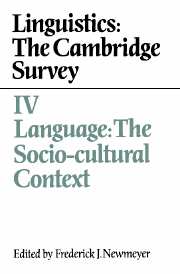Book contents
- Frontmatter
- Contents
- Contributors
- Preface
- 1 The study of language in its socio-cultural context
- 2 Language, culture, and world-view
- 3 Language and social class
- 4 Language and race: some implications for linguistic science
- 5 Language and gender
- 6 Bilingualism
- 7 Dialectology
- 8 Sociolinguistics and syntactic variation
- 9 Language birth: the processes of pidginization and creolization
- 10 Language death
- 11 Language planning: the view from linguistics
- 12 Ethnography of speaking: toward a linguistics of the praxis
- 13 The organization of discourse
- 14 Conversation analysis
- Index of names
- Index of subjects
- Contents of Volumes I, II, and III
13 - The organization of discourse
Published online by Cambridge University Press: 05 June 2012
- Frontmatter
- Contents
- Contributors
- Preface
- 1 The study of language in its socio-cultural context
- 2 Language, culture, and world-view
- 3 Language and social class
- 4 Language and race: some implications for linguistic science
- 5 Language and gender
- 6 Bilingualism
- 7 Dialectology
- 8 Sociolinguistics and syntactic variation
- 9 Language birth: the processes of pidginization and creolization
- 10 Language death
- 11 Language planning: the view from linguistics
- 12 Ethnography of speaking: toward a linguistics of the praxis
- 13 The organization of discourse
- 14 Conversation analysis
- Index of names
- Index of subjects
- Contents of Volumes I, II, and III
Summary
Introduction
The study of discourse belongs to the study of language in use, which means that it is concerned not just with the properties of linguistic representations but also with the nonlinguistic factors that determine what message is conveyed by the use of a linguistic form and whether it counts as an acceptable contribution to the communicative enterprise. While the linguistic properties of an utterance may determine a range of possible interpretations, the actual message recovered by the hearer depends on its nonlinguistic properties. Consider, for example, the exchange in (1):
(1) A: You're not eating.
B: It's too hot.
A grammar that pairs phonetic and semantic representations of sentences cannot determine the reference of you or it, what meaning of hot is intended, or what it is too hot for. Moreover, it is not evident from the linguistic properties of A's utterance whether he is informing the hearer that she is to refrain from eating, asking the hearer to confirm that she is not eating, or expressing his disapproval of the fact that the hearer is not eating. The hearer is expected to recover a specific message on the basis of nonlinguistic or contextual information.
Some writers, recognizing that the interpretation of an utterance is not fully determined by its linguistic properties as they are defined by a traditional sentence grammar, have argued that the grammar should be extended to include a pragmatic component that assigns interpretations to sentence–context pairs.
- Type
- Chapter
- Information
- Linguistics: The Cambridge Survey , pp. 229 - 250Publisher: Cambridge University PressPrint publication year: 1988
- 9
- Cited by

